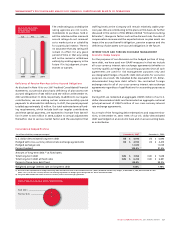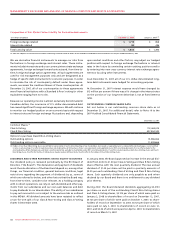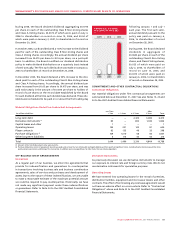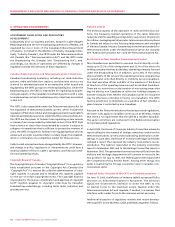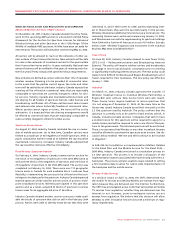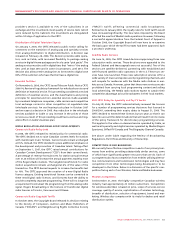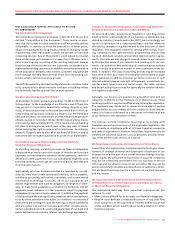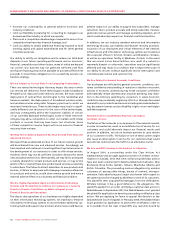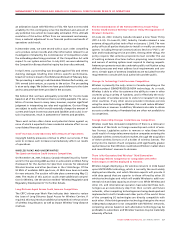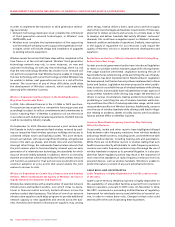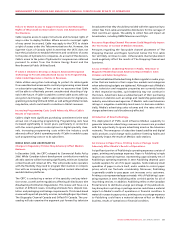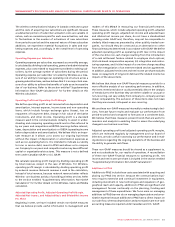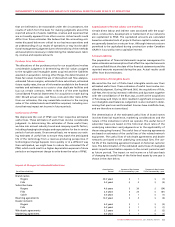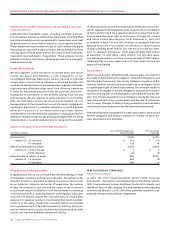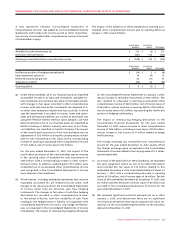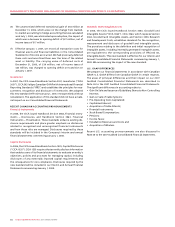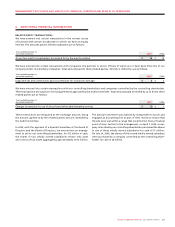Rogers 2007 Annual Report Download - page 61
Download and view the complete annual report
Please find page 61 of the 2007 Rogers annual report below. You can navigate through the pages in the report by either clicking on the pages listed below, or by using the keyword search tool below to find specific information within the annual report.
ROGERS COMMUNICATIONS INC. 2007 ANNUAL REPORT 57
MANAGEMENT’S DISCUSSION AND ANALYSIS OF FINANCIAL CONDITION AND RESULTS OF OPERATIONS
an arbitration clause with Wireless or Fido. We have not recorded
a liability for this contingency since the likelihood and amount of
any potential loss cannot be reasonably estimated. If the ultimate
resolution of this action differs from our assessment and assump-
tions, a material adjustment to our financial position and results of
operations could result.
In December 2004, we were served with a court order compelling
us to produce certain records and other information relevant to an
investigation initiated by the Commissioner of Competition under
the misleading advertising provisions of the Competition Act with
respect to our system access fee. In July 2007, we were advised by
the Competition Bureau that the inquiry has been discontinued.
In April 2004, a proceeding was brought against Fido and others
claiming damages totalling $160 million, specific performance,
breach of contract, breach of confidence and breach of fiduciary duty.
The proceeding is seeking to add Inukshuk Wireless Partnership, our
50% owned joint venture, as a party to the action. The proceeding
is at an early stage. We believe we have good defences to the claim
and no amounts have been provided in the accounts.
We believe that we have adequately provided for income taxes
based on all of the information that is currently available. The calcu-
lation of income taxes in many cases, however, requires significant
judgment in interpreting tax rules and regulations. Our tax filings
are subject to audits which would materially change the amount of
current and future income tax assets and liabilities and could, in cer-
tain circumstances, result in assessment of interest and penalties.
There exist certain other claims and potential claims against us,
none of which is expected to have a material adverse effect on our
consolidated financial position.
Tariff Increases Could Adversely Affect Results of Operations.
Copyright liability pressures continue to affect our services. If fees
were to increase, such increases could adversely affect our results
of operations.
WIRELESS RISKS AND UNCERTAINTIES
The Spectrum Auction Could Increase Competition.
On November 28, 2007, Industry Canada released its policy frame-
work for the upcoming AWS auction in a document entitled: Policy
Framework for the Auction for Spectrum Licences for Advanced
Wireless Services and other Spectrum in the 2 GHz Range. Of the
90 MHz of available AWS spectrum, 40 MHz have been set aside
for new entrants. The auction will take place commencing May 27,
2008. The results of this auction could create additional competi-
tion for Wireless. See the section entitled “Wireless Regulation and
Regulatory Developments” for further details.
Long-Distance Equal Access Could Increase Competition.
The CRTC’s three-year Work Plan indicates their intent to review
the issue of Long-Distance Equal Access for Wireless Carriers. If
required, this may introduce additional competition in the provision
of wireless long-distance, as well as impact Wireless’ long-distance
revenues.
The Recommendation of the National Wireless Tower Policy
Review Could Increase Wireless’ Costs or Delay the Expansion of
Wireless’ Networks.
On June 28, 2007, Industry Canada released a new Tower Policy
(CPC-2-0-03). On June 28, 2007, Industry Canada released a new
antenna siting policy that took effect on January 1, 2008. The new
policy affects all parties that plan to install or modify an antenna
system, including Personal Communications Services (“PCS”), cel-
lular and broadcasting service providers. Among other things, the
policy requires that antenna proponents must consider the use
of existing antenna structures before proposing new structures
and owners of existing systems must respond to sharing requests.
Antenna proponents must also undertake public notification using
defined processes and must address local requirements and con-
cerns. Certain types of antenna installations are excluded from the
requirement to consult with local authorities and the public.
Changes in Technology Could Increase Competition.
Wireless is presently the only carrier in Canada operating on the
world standard GSM/GPRS/EDGE/HSPA technology. As a result,
Wireless is able to offer its customers the ability to roam in other
countries using a variety of handsets, and is effectively the exclu-
sive provider of wireless services to visitors to Canada from many
other countries. If any other service provider introduces services
using the same technology as Wireless, this could reduce Wireless’
market share or revenue. In addition, Wireless is also able to obtain
access to a wide variety of handsets that are often not available to
its competitors.
Foreign Ownership Changes Could Increase Competition.
Wireless could face increased competition if there is a removal or
relaxation of the limits on foreign ownership and control of wire-
less licences. Legislative action to remove or relax these limits
could result in foreign telecommunication companies entering the
Canadian wireless communications market, through the acquisition
of either wireless licences or of a holder of wireless licences. The
entry into the market of such companies with significantly greater
capital resources than Wireless could reduce Wireless’ market share
and cause Wireless’ revenues to decrease.
There is No Guarantee that Wireless’ Third Generation
Technology Will Be Competitive or Compatible with Other
Technologies or Will Be Deployed as Planned.
Wireless began deploying a 3G wireless network in 2006 based
upon UMTS/HSPA technology, which is currently the most widely
deployed worldwide, and which Wireless expects will provide it
with data speeds that are superior to those offered by other 3G
wireless technologies and which will enable Wireless to add incre-
mental voice and data capacity at a lower cost. While Wireless and
other U.S. and international operators have selected these tech-
nologies as an evolutionary step from their current and future
networks, other competing technologies are being developed and
implemented in both Canada and other parts of the world. None
of the competing 3G technologies are directly compatible with
each other. If the third generation technology that gains the most
widespread acceptance is not compatible with Wireless’ networks,
competing services based on such alternative technology may be
preferable to subscribers and Wireless’ business may be materially
adversely affected.


